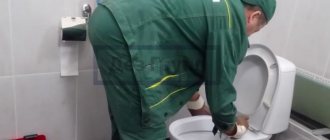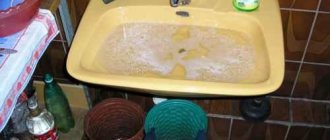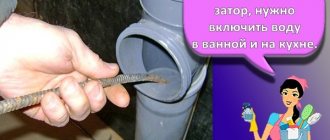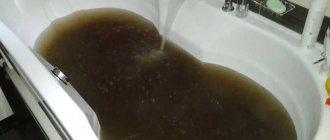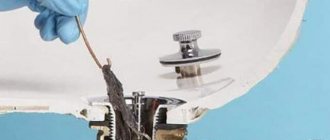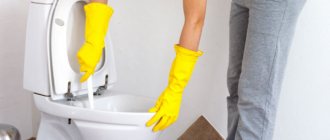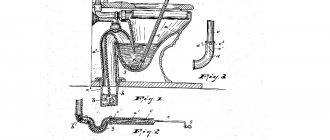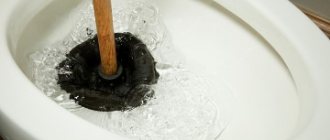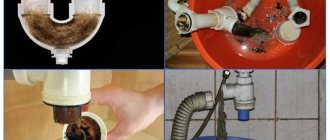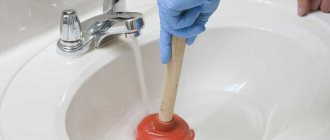Does the water in the toilet drain poorly, or does it even stand still, forming a small, stinking swamp? Don't be so quick to blame the plumbing manufacturer. Typically, 65% of blockages occur not due to the design features of the “faience throne”, but due to the fault of household members. Another common cause of this household problem is imperfect sewer systems. Most of them are long outdated, or even in disrepair.
Residents of multi-storey buildings encounter the problem of blockages more often than residents of cottages. The reason is simple: cottages, as a rule, are equipped with new or refurbished and improved utility networks. Servicing a cottage sewer system is not too complicated and not as expensive as in a high-rise building. In addition, the owner of the house can control the work independently, while residents of apartment buildings do not have this opportunity. And perhaps it was not you who threw the banana skin into the toilet, but Avdotya Nikolaevna, who lives above you. But the problem came down to you. And it's up to you to decide.
Causes of a clogged toilet
A clogged toilet will never bother you if you use your plumbing correctly.
Why pipes get clogged:
- A man flushes leftover food into the toilet. They, in turn, settle in the pipes, creating an impassable blockage. Particularly dangerous are fatty scraps, poorly or insoluble parts (kernels from berries, for example). If you don’t have the strength to send food waste to a garbage chute or outdoor bin, regularly prevent blockages in the toilet and pipes.
- The accumulation of household waste is an equally popular reason. Paper, bags, hair, and hygiene items should be thrown into the trash. Only toilet paper dissolves in water; everything else clogs the drain.
- Improper installation of plumbing, due to which all waste is poorly washed off, accumulates and creates blockages. Usually this reason makes itself felt soon after the installation of new equipment.
- The toilet is clogged due to cat litter. Silica gel clay granules cannot be washed off, as they absorb moisture and stick together. Wood filler can be washed off, but only in small quantities. A large filling will swell and, like a plug, block the drain or pipe.
- Often, drains become clogged due to salt deposits, and they accumulate due to hard water and urea sediment. Plaque builds up on the walls, narrowing the pipes and making them difficult to pass.
Even the smallest accumulation of debris is easy to detect, allowing you to quickly intervene and clean the pipes.
These are the signs that indicate a clogged toilet:
- water flows too slowly into the drain;
- Water accumulates in the toilet and does not drain;
- an unpleasant and sometimes nightmarish smell appears.
If any of these signs occur, urgent measures must be taken, otherwise the blockage will develop into a large-scale problem and you will have to call plumbing services. The toilet can be cleaned using both mechanical and chemical means. In case of lack of necessary items, folk techniques will come to the rescue.
If a blockage is detected, it is not recommended to flush water from the tank, since it contains at least 3 liters of liquid. Water, clean and dirty, will flow onto the floor. Before cleaning the toilet, turn off the water supply. After removing the blockage, water for testing is poured into the toilet with a bucket, no more than 1 liter at once.
What are the causes of blockages?
In the professional environment, it is customary to distinguish between three types of blockages, which impede the passage of water or even completely block the passage.
Types of blockages:
- Operational
- Mechanical
- Technological
Operational blockage
This type of blockage is the most common and occurs most often. It is associated with the entry of various household waste, fat, six animals, toilet paper, and hair into the sewer system. All this leads to the formation of deposits on the walls of the pipes, slowing down the drainage flow and further clogging of the pipe. A plumbing cable will help solve the problem; it will easily clean the sewer.
Mechanical blockage
This is the most complex type of blockage, the main cause of which is carelessness and inattention when a foreign rather large object, a child’s toy, etc. gets into the sewer pipes. Moving along the sewer passage, it will get stuck in the joints or bends of the system, reliably blocking the passage. Using various chemicals or a plunger does not completely solve the problem. If using a cable does not help, you may need to disassemble the pipeline and remove the foreign object.
Technological blockage
The type of blockage is not susceptible to the action of either a cable, or chemicals, or traditional cleaning methods: soda, vinegar, boiling water - this is wear on the pipes and errors in the design and installation of the sewage system in the apartment. Having broken through the sewer, after a while you are forced to remove the blockage again and again. Incorrect pipe slope, worn pipes, and improper installation of joints reduce the flow of the treatment plant, creating blockages and blockages in the pipes. The only thing that is possible in such a situation is replacing the pipes or installing the sewer system in a new way, taking into account the project and specialists. Using a cable only solves the problem temporarily.
Plunger: the main remedy against blockages
If the toilet is very clogged, it can only be cleaned mechanically. Fortunately, at home there is almost always a plunger (a convenient toilet plunger with a cone on a rubber attachment).
How to use a plunger to pierce a toilet:
- Fill the toilet about a third full with water. The plunger will only create pressure when immersed in water.
- Place the object so that its edges cover the drain hole as much as possible.
- Using pressure and a sharp return movement, break through the blockage.
- Repeat the movement until the water begins to rapidly flow down the drain.
Tip: To quickly clear a clogged toilet using a plunger, lubricate its edges with Vaseline. This way the tool will be better fixed on the walls of the plumbing fixtures.
Tool selection criteria
When choosing a product, you need to touch and inspect it for mechanical damage. The cable should not have any bending memory. Make sure the handle is securely fastened. Pay attention to the pipe. It should be a little springy and plastic.
All elements of the tool, including nozzles intended for impact, must be made only of high quality steel.
The main parameters that should be considered when choosing a plumbing cable:
- Device diameter . The size of plumbing cables available for sale ranges from 6-18 mm. The required size of the rods is selected based on the diameter of the laid pipes and the complexity of the blockage.
- Design . The handle can be L- or Z-shaped. Handles equipped with a locking system are available on sale. They are convenient because they hold the rods and at the same time allow them to be rotated in any direction.
- Complete set of replaceable nozzles . Among the variety of replaceable nozzles on the market, the most popular are “harpoons”, with the help of which it is convenient to remove large elements of dense plugs, and reinforced punches, capable of breaking through the hardest blockages.
How to clean a toilet with a cable
A plumbing cable is a special device for when a plug of debris is lodged deep in a pipe. The cable bends easily, at one end there is a convenient holder, at the other there is a metal brush, cone or hook, which breaks through the blockage and partially pulls it out. The optimal length of the device is 1 m.
To make a passage in the toilet with a cable, you need the following:
- Before using the cable, prepare a piece of scrap rag to place the item on after removing it from the drain.
- Lubricate the cable with detergent.
- Immerse the device into the toilet drain hole as deeply as possible until the brush hits an obstacle - an accumulation of debris.
- Rotate and push the cable until it slides deeper.
- Debris can be picked up and then pulled to the surface.
- If the water begins to drain rapidly, the blockage has been cleared; all that remains is to rinse the toilet with detergent.
Tip The special cable is replaced with a wire with a hook-shaped end.
Main types of plumbing cables
The plumbing cable used for cleaning is a flexible shaft that performs the function of transmitting torque. The tool is used not only for “punching” sewer pipes, but also for cleaning water supply lines, as well as treating the inside of boiler and boiler pipes.
The tip performs two functions:
- holds replaceable tools that can be used to facilitate the cleaning process;
- prevents self-unraveling of the cable, thereby extending the service life of the product.
The cable structure is represented by a rod or shaft, the central part of which is equipped with a core. Wire strands are wound around the core in several layers in different directions.
The direction of the strands of each layer alternates: the first layer is laid to the right relative to the axis, the second - to the left. When manufacturing the core, the number of layers of strands is repeated until a certain shaft diameter, specified by technological standards, is reached.
In addition to the main function - clearing blockages in the water supply and sewerage systems, cables are often used to remove blockages in boilers and boilers, as well as to clear soot from chimneys.
There are three main types of tools on sale: rope, spring-wound and spring.
It should be remembered that when cleaning with a cable, earthenware plumbing can be seriously damaged. In order not to lead the situation to the need for mechanical destruction of the blockage, the following preventive measures are recommended:
Rope type device
The rigging cable is used to clean small clogged sections of the pipeline inside the apartment. It is made of galvanized durable steel, which is famous for its high strength and durability. Rope-type products are traditionally made with a diameter of 6 mm, due to which they are flexible and resilient.
The end of rope-type products is crimped with a tip to prevent unraveling of the wire threads. To make it easier to remove hairballs from the pipeline, manufacturers give the tip a fluffy brush shape.
To clean the plumbing inside the apartment, rigging cables with a length of 2.5 to 5 meters are used. It is not advisable to purchase longer products, since the main line rarely exceeds a length of 5 meters.
Spring-wound cable
A spring-wound cable is a more rigid product, the diametrical cross-section of which is at least 9 mm. It is chosen for cleaning toilets, as well as indoor water and sewer pipes.
This cable is equipped with a rotating handle, which has a curved shaft design. The device ends with a bend or tip, with the help of which it is easily moved into the cavity of the pipe. Devices of this type for domestic use are not equipped with special attachments.
Thanks to the excellent elasticity of the tool, despite the sufficient rigidity of the structure, the cable easily copes with all difficult obstacles in its path.
Spring spiral with tensioner
The spring cable belongs to the category of professional equipment. It is used by plumbers to break through serious, complex blockages in both horizontal pipes and vertical risers. The diametric size of products varies in the range of 13.5-16 mm. The length can reach from 25-60 meters.
Small-diameter products are used for cleaning toilets, urinals and sewer pipes in public places. A large-section spring with increased rigidity is used when it is necessary to remove blockages from sewer risers passing through interfloor ceilings
As the diameter of the cable increases, the size of the wire used for its manufacture also increases:
- for products with a thickness of 10-12 mm, use a metal cord D 1.4 mm;
- for 14 mm cables – thread D 1.4 mm;
- for rods D 16 mm - wire D 2.1 mm.
Spring-type products, like their simpler analogues described above, are equipped with a handle. But in models of this type it serves as a tensioner. At the moment of rotation and tension, the spring acquires special rigidity, thanks to which it easily destroys even the most complex blockages.
In professional models used for long pipes, the handles are often made sliding. Due to this, they easily move along the length of the rod and are fixed in the desired position. This design solution allows you to avoid coiling the cable during operation.
Depending on the model, the equipment may be equipped with various types of attachments.
They are selected based on three parameters:
- pipe type;
- material of their manufacture;
- design features (presence of joints and elbows).
To break through crumbs of stone and sand, use a bottom nozzle; to remove compressed blockages, use a punching tip; and to remove lumps of dirt and old rags, use nozzles in the form of loops and hooks.
How to do without a plunger and cable
Is the clog problem solved without a plunger and cable? The problem is eliminated with the help of chemistry. The most convenient way to clean the toilet is with various gels. Such products are harmless to the sewer system; they corrode accumulated debris almost instantly; in addition, they remove dirt and disinfect the surface of the toilet bowl. The composition contains alkalis or acids that quickly destroy small debris, including hair.
Before purchasing such a product, you need to study the instructions, since not all products are suitable for different types of pipes: plastic and metal:
- “Domestos”, “Mister Muscle”, “Tofix” are suitable for all types of pipes;
- For metal pipes, domestic products “Mole”, “Chimney Sweep”, “Ruff” are recommended.
How to properly use industrial anti-clog products:
- The dosage of the gel is measured strictly according to the instructions.
- The required amount is poured into the toilet hole.
- Then a little water is poured in. The liquid will move the gel closer to the debris accumulation.
- If the toilet is very clogged, you will have to wait at least an hour, or even two.
- After time, the toilet is flushed with hot water. Remember to pour water in small portions to avoid an unplanned flood.
- Never mix two different industrial products. An unexpected chemical reaction will ruin your plumbing without any chance of recovery.
- After working with chemicals, you need to ventilate the toilet room. The smell is toxic. Don't forget to use a mask to protect your respiratory system.
If the household does not have a plunger or a cable, you can clean the plumbing with improvised means, for example, a plastic bottle. Suitable containers with a volume of 1.5 or 1.5 liters. How to proceed:
- Cut the bottom of the bottle with a knife or scissors.
- Tighten the plug on the neck.
- It turns out to be an improvised plunger.
- Insert the edges of the bottle into the drain hole.
- To unclog the toilet, push the bottle into the water and quickly remove it, and so on several times.
Some housewives decide to take drastic measures by pouring hydrochloric or sulfuric acid into the toilet. Such a powerful tool will clear the blockage, but it can also corrode the pipes. Be careful and choose gentler methods.
Chemicals: effectiveness and features of use
There are many types of chemicals intended for similar purposes; another thing is that they do not always help, but it is definitely worth trying them before embarking on more serious operations. These chemicals can come in the form of liquids, granular substances, powders and even sprays. The use of each of them may depend on the type of blockage, which should also be taken into account when choosing. The most well-known and frequently used solutions are:
- "Mole"
- "Tiret"
- "Drano", etc.
The principle of their action is to dissolve the possible cause of the blockage, thus clearing the way for the normal passage of water flows. You just need to pour the amount of chemical specified in the instructions deep into the drain hole and wait a certain period of time, which can vary from 40 minutes to 8 hours .
After which everything is washed off generously with hot water. They contain alkaline substances, which is why it is highly not recommended to increase the time of use specified in the instructions. It is better not to consider the use of any gentle means for cleaning the toilet as a possible option, since they are of little , and a pleasant smell in such procedures is not an indicator. But, in order to prevent subsequent blockages, you can and even need to have on hand some means of appropriate purpose.
How else to clean the toilet: proven folk remedies
Soda and vinegar are a tandem that has helped out more than one housewife. To remove a clog in the toilet, you will need a mixture of soda and 70% acetic acid; table vinegar is not concentrated enough.
Folk method for clearing clogs:
- Scoop out excess water from the toilet.
- Pour a package of baking soda into the toilet and push it deep with a brush.
- Pour the acid after the soda. The reaction will begin.
- Wait a few minutes until the hissing stops.
- To fix the problem faster, pour a glass of boiling water after the vinegar. The reaction will go many times faster. Important: the plastic connecting corrugation between the toilet and the pipe may not withstand the action of boiling water.
Another method that folk wisdom suggests is a mustard solution. For 1 tsp. powder, take 2 liters of hot water. All this is poured into the toilet and sits for several minutes. Then you need to pour in some water and check how it goes. If the water gets stuck, you need to try again.
Features of cleaning the toilet with a cable
A plumbing cable is a hollow tube equipped with a handle for rotation. Its working surface has a spiral shape, thanks to which stuck debris is cleared.
The essence of mechanical cleaning is to break through the bolt using a cable. All you need to do is rotate the handle and at the same time push the product inside the sewer pipe. This procedure can be performed either with an assistant or independently.
A metal cable is indispensable when the toilet is clogged so tightly that a plug has formed inside the sewer pipe. The use of liquid products in such cases often does not help or takes too much time.
How to prevent a clogged toilet: tips
To ensure that toilet cleaning is a rare event, the equipment must be taken care of. Prevention of blockages comes down to the following rules:
- You need to use the toilet for its intended purpose, no matter how stupid it may sound. Do not flush away large household waste, construction waste, or cat litter.
- It is worth periodically flushing all drains with hot water.
- It is recommended to clean all drains with chemical drain gels every few months.
Important: The accumulation of garbage does not live in the toilet, but in the common pipe, which will be revealed if you open all the taps in the apartment and watch how the water flows. If the flow slows down everywhere, then the problem is not in the toilet, but much deeper. Such a blockage can only be removed with the help of special services.
Removing a toilet clog with your own hands is not the most pleasant procedure and is often long, so do not neglect preventive rules and keep various cleaning devices in the house just in case.
Reasons for the “swamp” in the bathroom
Knowing how to unclog a toilet if it is clogged, of course, you can eliminate the blockage. However, ignorance of the reasons for its appearance will return you to the problem again and again. Experienced plumbers identify the three most common causes of stagnation.
- Ignoring operating rules. Users often neglect the rules for using the toilet. They throw toilet paper and personal hygiene items into it, deliberately use it as a trash can, or mistakenly let small items go inside. This happens especially often where children live: children perceive the toilet as a mini-pool for experiments and every now and then they strive to use it for other purposes.
- Illiterate installation of plumbing fixtures. Correct installation of pipes and proper placement of the toilet in relation to the riser is 50% of success. If the installation of plumbing was done “by touch” and without the presence of a specialist, sooner or later the new equipment will remind you of the mistakes made.
- Design features of the toilet. By giving preference to unknown manufacturers, you risk running into low-quality products. A distinctive feature of such toilets is their fragility and ill-conceived design.
The first thing to do if the toilet is clogged is to determine the extent of the blockage. To do this, you need to pour a liter of water into the toilet, and after half an hour, see how much the liquid level has decreased.
